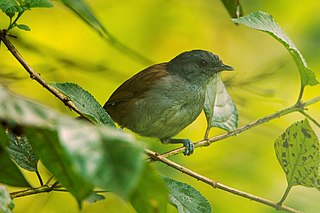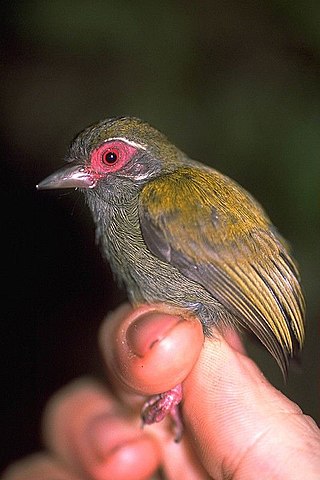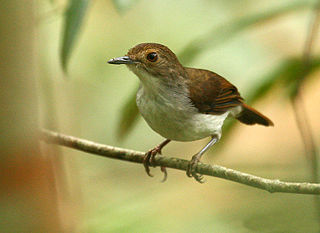
The puff-throated babbler or spotted babbler is a species of passerine bird found in Asia. They are found in scrub and moist forest mainly in hilly regions. They forage in small groups on the forest floor, turning around leaf litter to find their prey and usually staying low in the undergrowth where they can be hard to spot. However, they have loud and distinct calls, including a morning song, contact and alarm calls. It is the type species of the genus Pellorneum which may, however, currently include multiple lineages.

The yellow-billed babbler is a member of the family Leiothrichidae endemic to southern India and Sri Lanka. The yellow-billed babbler is a common resident breeding bird in Sri Lanka and southern India. Its habitat is scrub, cultivation and garden land. This species, like most babblers, is not migratory, and has short rounded wings and a weak flight and is usually seen calling and foraging in groups. It is often mistaken for the jungle babbler, whose range overlaps in parts of southern India, although it has a distinctive call and tends to be found in more vegetated habitats. Its name is also confused with Turdoides leucocephala, which is also known as white-headed babbler.

The dark-fronted babbler is an Old World babbler found in the Western Ghats of India and the forests of Sri Lanka. They are small chestnut brown birds with a dark black cap, a whitish underside and pale yellow iris. They forage in flocks in the undergrowth of forests constantly making calls and uttering alarm calls when disturbed.

The red-thighed sparrowhawk, alternatively known as the red-legged sparrowhawk or western little sparrowhawk, is a species of sparrowhawk in the family Accipitridae from western and northern central Africa. This species was formerly placed in the genus Accipiter.

The large hawk-cuckoo is a species of cuckoo in the family Cuculidae. It has a wide breeding distribution from temperate Asia along the Himalayas extending to East Asia. Many populations winter further south. They are known for their loud and repetitive calls which are similar to that of the common hawk-cuckoo but do not rise in crescendo. They are also somewhat larger and adults can be readily told apart from the smaller common hawk-cuckoo by the black patch on the chin. They are brood-parasites of babblers and laughing-thrushes.

The akun eagle-owl is a species of owl in the family Strigidae and is native to the African tropical rainforest.

Abbott's babbler is a species of bird in the family Pellorneidae. It is widely distributed along the Himalayas in South Asia and extending into the forests of Southeast Asia. They are short-tailed and stout birds which forage in pairs in dense undergrowth close to the ground and their presence is indicated by their distinctive calls.

The ashy-headed babbler is a species of passerine bird in the ground babbler family Pellorneidae. The species is also known as the ashy-crowned babbler. The species is closely related to the short-tailed babbler. The two species are sometimes treated as the same species but differ in their calls. The species is monotypic, meaning it has no subspecies.

Pellorneum is a genus of passerine birds in the family Pellorneidae. Some of its species were formerly placed in the genus Trichastoma.

The Javan black-capped babbler is a species of bird in the family Pellorneidae. It is endemic to the island of Java in Indonesia. The Malayan black-capped babbler and the Bornean black-capped babbler were both formerly considered conspecific, but were split from it in 2021. Its natural habitat is subtropical or tropical moist lowland forest.

The African hill babbler is a species of bird in the family Sylviidae.

The marsh tchagra or blackcap bush-shrike is a species of passerine bird placed in the monotypic genus Bocagia in the family Malaconotidae. It is native to marshes in the tropics and subtropics of Africa. It is sometimes placed in the genus Tchagra.

The Sumatran babbler is a species of bird in the family Pellorneidae.
The Malayan swamp babbler, previously named the white-chested babbler, is a species of bird in the ground babbler family, Pellorneidae, that is found in the Malay Peninsula, Sumatra, the Riau Islands, the Lingga Islands and the island of Belitung. It was formerly considered to be conspecific with the Bornean swamp babbler.

The African piculet, sometimes placed in the genus Sasia, is a species of bird in the family Picidae. It is the only species placed in the genus Verreauxia. It is found in Angola, Cameroon, Central African Republic, Republic of the Congo, Democratic Republic of the Congo, Ivory Coast, Equatorial Guinea, Gabon, Ghana, Liberia, and Uganda. This species is described as locally common and has a very large range, so the International Union for Conservation of Nature has rated its conservation status as being of "least concern".

The Bicol ground warbler is a species of passerine bird in the family Locustellidae. It is native to southern Luzon and Catanduanes in the Philippines. It was formerly conspecific and forms a species complex with the Cordillera ground warbler and Sierra Madre ground warbler, which are some of most elusive birds in the country due to their extremely shy nature. Its natural habitat is tropical moist lowland forest. It is threatened by habitat loss.

The Sulawesi pitta is a species of pitta. It was considered a subspecies of the red-bellied pitta. It is endemic to Indonesia where it occurs in Sulawesi, Manterawu, and Togian Islands. Its natural habitat is subtropical or tropical moist lowland forest. It is threatened by habitat loss.
The glissando babbler is a species of bird in the ground babbler family Pellorneidae. It is found on the Indonesian islands of Bangka and Belitung as well as west and southwest Borneo. It was formerly considered to be a subspecies of the short-tailed babbler, now renamed the mourning babbler.

The leaflitter babbler is a species of bird in the ground babbler family Pellorneidae that is found in northern and central Borneo. It was formerly considered to be a subspecies of the short-tailed babbler, now renamed the mourning babbler.

The Bornean swamp babbler is a species of bird in the ground babbler family Pellorneidae that is found in northern and central Borneo and Banggi Island. It was formerly considered to be a subspecies of the white-chested babbler, now renamed the Malayan swamp babbler.


















